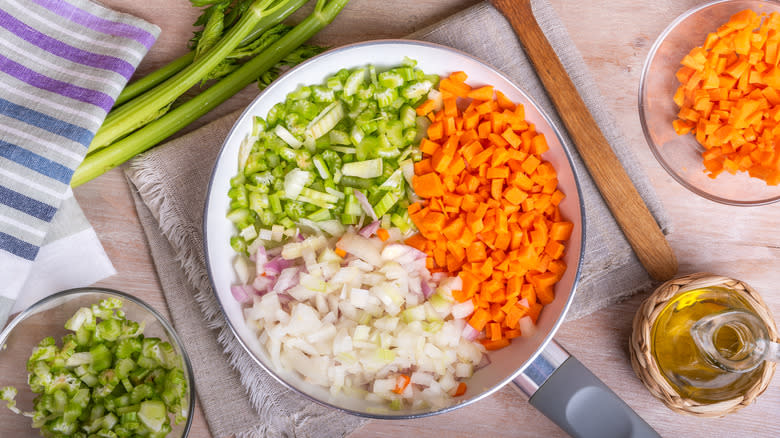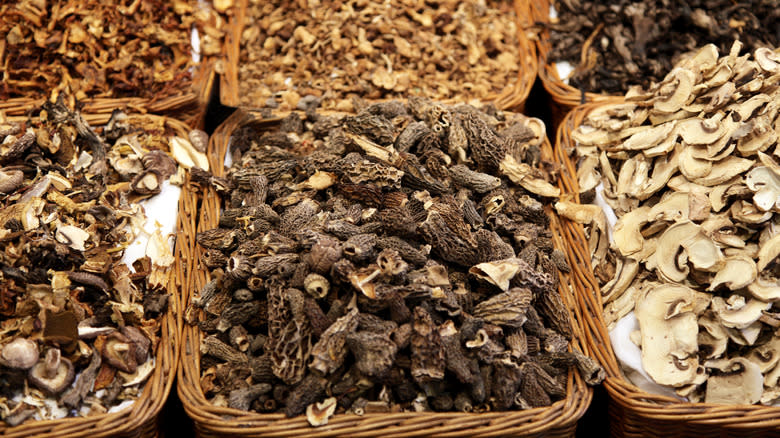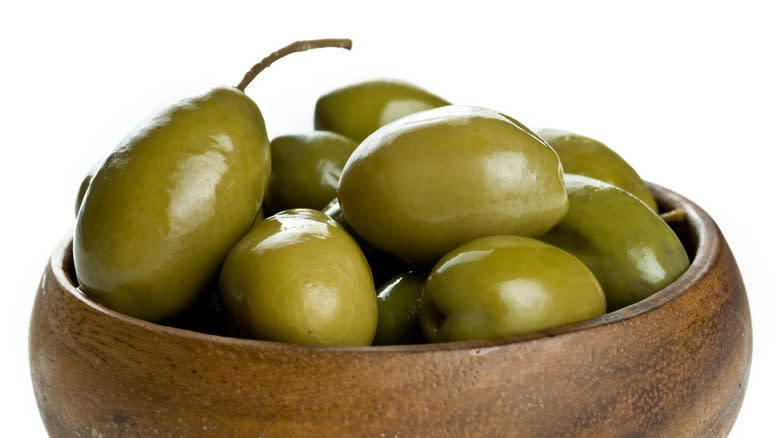14 Ways To Add More Flavor To Store-Bought Chicken Broth

Chicken broth, a staple in kitchens worldwide, serves as the foundation for countless dishes. Whether you're simmering a hearty soup, braising tender meats, or adding depth to sauces and gravies, its versatility knows no bounds. While homemade chicken broth is the pinnacle of quality, the store-bought kind offers a convenient solution for home chefs seeking to streamline their cooking process. This product eliminates the need to spend hours boiling down bones, vegetables, and herbs to achieve a rich, savory base. Beyond time-saving benefits, store-bought chicken broth boasts consistency and reliability, ensuring a predictable flavor profile with every use. Packaged in convenient containers ranging from cans to cartons, it's easy to store and portion, ready to enhance dishes at a moment's notice.
The main problem with this hack is that the flavor tends to suffer. Because let's face it -– store-bought chicken stock isn't the most sophisticated food in the world. It often lacks flavor, depth, and all the qualities you want to make a standout dish. But that doesn't mean you have to give up on the convenience of it. Rather, we propose a number of ways you can add more flavor to store-bought chicken broth quickly and easily, without having to start from scratch. So let's take a look at some of the best methods for pulling this off.
Read more: The 20 Best Olive Oils For Cooking
Start With A Mirepoix

A mirepoix is a simple base that can be used for many soups. It is typically made from finely diced onion, carrots, and celery that have been cooked slowly, and at length, in oil or butter. While you can certainly use this combination in a homemade stock, its presence will elevate a boxed broth to a whole new level. Once the mirepoix is well on its way, it'll start to take on a flavor and texture of its own, so if you wanted to include recognizable carrots or celery in the soup or stew you're making, you're going to have to add these separately later in the cooking process, after they would have a chance to disintegrate.
The beauty of this flavor hack is that you can also play around with the mirepoix idea and use similar techniques from other cultures. For instance, in Spain and other Latin countries, chefs often use a variation called sofrito, which includes garlic and tomatoes in addition to the other three ingredients. Likewise, Germany's suppengrün also uses leeks and celeriac.
Simmer It With Added Proteins

If your boxed broth tastes fine but is lacking in flavor, the simplest thing to do sometimes is to just add more of what's already in there. For example, if you're dealing with chicken stock, simmer it with more chicken. The best parts to use for a stock are the bones, skin, and even the feet, and if you can spare some extra meat on those bones, all the better.
If you're working with a vegetarian stock, simmer it with more vegetables or add in some tofu, for an extra protein boost. The vegetables should be sautéed on their own first, in the style of a mirepoix or sofrito, for maximum flavor. The fun part is that you can play around with your favorite items here, and you don't have to stick to the usual carrots, onions, and celery. Although all this may feel a bit like cooking the broth from scratch, it's not the same thing. It won't take nearly as long to infuse the flavor if you're already starting with a base.
Add Canned Chicken

Ina Garten recommends using a whole chicken, meat shaved off, to prepare a homemade stock. This is sound advice, of course, but if you don't have time for the whole nine yards, you can concoct a sort of hybrid stock that falls somewhere between homemade and store-bought. For the best of both worlds -- the convenience of boxed and the flavor of homemade -- try putting a whole canned chicken into your store-bought stock.
There are several upsides to this strategy. First, both your stock and your canned chicken are shelf-stable when unopened, so you can buy them both and have them on hand whenever you need to cook up a quick stock. Second, whole canned chicken tends to be more affordable than the fresh kind. And lastly, it's simple enough to just add those bones to a quick vegetable saute before pouring in the box of broth. With a homemade broth, you'd then need to simmer this for about four hours, but in this scenario, about 30 minutes should be enough to fortify it and give a hefty flavor to your soup or stew. Meanwhile, you can use the extra meat from the canned chicken to further heighten the flavor of your stock, or you could add it to a slew of other recipes, like chicken pot pie or chicken salad.
Throw In A Parmesan Rind

We can always count on Parmesan cheese to add flavor to a dish. Whether it's included during cooking or freshly grated on top as a finishing touch, a little Parmesan goes a long way. But next time you get down to the nub, don't just toss it in the bin. The rind can be used too, and it has almost as much flavor as the freshly grated stuff -- it just takes a little longer to release the flavor.
All you have to do is grab that cheese rind out of the fridge and plop it in a pot with your store-bought broth. You can cook it with aromatics, dried mushrooms, and other ingredients, but you don't have to. The beauty of this tactic is that you just need one added ingredient to spruce up your stock. You may need to simmer it for a while to soften it and draw out the flavor, but this won't require any extra labor on your part.
Remember The Garlic

If you like the idea of upgrading your boxed stock with a mirepoix but can't stomach all that cutting and chopping, consider the humble garlic clove instead. With this little guy, all you have to do is peel off the skin, crush it in one swift motion, and saute it in some olive oil before pouring it into the stock. This trick will instantly infuse your stock with the warm and powerful flavors of garlic without making too much extra work for you.
The benefit of garlic is that in all likelihood, your stock already contains some, so added garlic won't alter the overall flavor profile of this liquid. Cleanup is just as simple: once the garlic cloves have done their job, just strain them out with a slotted spoon. Or leave them in for the occasional burst of garlicky goodness. Meanwhile, the garlic will have done its job and then some by enhancing all the other ingredients in the stock. Not only will it have added its own signature flavor to the mix, but it will also have opened up your taste receptors with its pungent aroma, allowing more of the other stuff to reach you.
Stir In Chicken Bones, Fat, And Skin

Most homemade chicken stock is made with bones, and the store-bought stuff might not even contain that. But chickens have a lot more to offer the stock-making process than just their bones. While leaving some extra meat on there can certainly help, the bulk of the flavor and texture will come from the gelatinous nature of the skin and fat.
This is why you should cook with chicken fat and skin if you can, whether you're making a homemade stock or fortifying a store-bought one. Either way, you'll be adding oodles of flavor to the liquid, while at the same time doing your part for sustainability by using as much of the animal as possible. Indeed, you can also use the neck, knuckles, and marrow if you can get your hands on them. And don't stop at chicken. Beef, lamb, pork, and even goat meat all have their own unique flavors that can add taste to your stock. In practical terms, it's just a matter of adding the materials to your stock or to the initial sauté. The latter option is especially ideal for the fat, which can be rendered and used to fry up your mirepoix.
Involve Vegetable Scraps

While you can't go wrong with a fresh mirepoix of carrots, celery, and onion, you can also use certain vegetable scraps to add flavor to your store-bought stock. If you play your cards right with this hack, you may never have to throw food out again. Remember those carrot peels you produced the other day when you were preparing your salad? Throw those into your stock. Do you have some leftover fennel greens that you don't know what to make of? Toss them in the pot.
That said, not all vegetables lend themselves well to enhancing the flavor of stock. There's a reason you've never seen Brussels sprout leaves floating in your broth. They and other crucifers -- like cauliflower or broccoli -- contain high amounts of sulfur, which can turn the flavor of a stock funky when cooked down and simmered for long periods of time. Zucchini and pumpkin peels have a similar effect. That is not to say that you can't add kale to your soup -– just make sure you do so toward the end of cooking. This will also keep the leaves crisp and tasty.
Combine It With White Wine

A splash of white wine in stock, stew, sauce, or anything that's meant to come out as a liquid can instantly add flavor without messing with texture. The ideal pick is something with dry notes, like a pinot grigio or a sauvignon blanc, or you might end up with a slightly sweet stock. And don't bother spending too much money on this -- an inexpensive bottle from the supermarket or local liquor store will do just fine, as most of the flavor is going to be subsumed into the stock.
As for how to use it, pouring it directly into your stock before you take it off the heat can be a nice touch, but the best method is to pour it on your mirepoix if you're using it, sauteing it in the wine for a little while before the stock goes in. This will help concentrate the flavors of the wine, but not the alcohol content -- as you cook the wine, the alcohol will evaporate, leaving your end result alcohol-free and safe to consume for people of all ages.
Pour In Some Vinegar

A touch of acid might be just what your store-bought stock needs to achieve the perfect balance of flavors. That slight bite from the acid will brighten the taste of any tired and dull stock. All you need is to add one or two tablespoons to the simmering stock to achieve the desired effect.
Acid can also thicken a stock without significantly altering the composition, especially if you decide to use white wine vinegar or apple cider vinegar, which have a milder flavor than some other types of vinegar. This is mainly true when dealing with homemade stock, as the thickening happens when the acids from the vinegar go to work on the soaking bones and cartilage. But if you're adding your own chicken bones to the store-bought stock to fortify it, the acid from the vinegar can speed up the process of dissolving the connective tissue in the bones, which in turn will thicken the broth.
Drop In Some Bullion Cubes

Drop a bullion cube into anything -- tomato soup, pasta sauce, stew, you name it -- and your concoction will become instantly saltier and more flavorful. This is also true of store-bought chicken stock. Indeed, bullion cubes are often used as stock when dissolved in hot water. You might even think that using both stock and bullion would be redundant.
But only until you remember that store-bought stock can be so lacking in flavor that you'll be clawing at your cupboards to find something to fix that predicament. The simplest solution is to drop in bullion, which is basically a concentrated stock in cube form. Giving more of the same flavor to your broth will thus intensify it without altering its flavor profile. This is what Ina Garten does when she makes her chicken pot pie, where she adds two bullion cubes to 5 cups of chicken stock. If it's good enough for Ina, it's good enough for us.
Sprinkle In Some Dried Mushrooms

Dried mushrooms are a go-to ingredient for adding umami to any dish, especially if you're looking for a vegetarian source. And one of the most knowledgeable chefs on the topic of umami is none other than David Chang, who likes to flavor his chicken stock with those dried mushrooms combined with freeze-dried chicken. Both these ingredients, by virtue of being dried, have concentrated flavors, which is exactly what you need when you're trying to amp up a bland boxed broth.
As these elements rehydrate in your stock, all those flavors will come pouring out, infusing the liquid with their warm, earthy tones. The great thing about using these ingredients, other than the taste factor, is their simplicity. Just pour your boxed stock into a pot, set it to medium-low heat, and drop in the mushrooms and chicken. Chang recommends using about 1 cup of dried mushrooms per quart of stock and a similar amount of freeze-dried chicken. Or you can use one or the other instead of both -- either way, you're going to end up with a more flavorful liquid.
Amp Up The Umami With Olives

There are a lot of ways to upgrade a store-bought chicken broth with more meat. Extra bones, fat, and skin are all top choices. But what if you've had enough meat and want to go the plant-based route? That's where olives and their brine come in. Together, they add that hint of umami and acidity that can instantly upgrade a stock without the need for any fish or meat-based ingredients.
For this hack, you can use both whole or pitted olives, adding them in with other produce, if you're using it, before pouring in the liquid. The pits come with their own set of flavors and can provide hints of fruitiness and a slight bitterness that is not altogether unwelcome. You can also get creative with the types of olives you use. Fleshy Castelvetrano olives will work just as well as the smoky kalamata ones -- the stronger the flavor of the olive, the stronger the effect on your stock. Just remember to adjust the quantities of olives according to your taste. With the strongest varieties, you'll need no more than a handful.
Concentrate It

If you open up store-bought stock and sample it, only to find that it tastes like water, then you're going to need to do something to increase its flavor. One great way to do this without altering the flavor profile is to boil it down and reduce it to a concentrate. After all, this amounts to the initial stages of the making of a bullion cube, which is essentially concentrated chicken stock.
To make this work, you'll have to reduce the stock by half, at least. Not only will this concentrate the flavors but it will also thicken the stock, since much of the water will have evaporated. To aid in this evaporation, cook your stock in a wide, shallow pan. The more water is exposed to air, the quicker it will evaporate and concentrate your stock. Feel free to cook it for as long or as little as you want. The intensity of the flavor will depend on it, but the strength of it is ultimately up to you.
Spice It Up With Fresh Ginger

Ginger works in much the same way as garlic does when it comes to adding flavor to stock. Meaning, toss it in with your other vegetables and you'll be met with a pungent, taste receptor-opening element that will leave you primed to further enjoy the other tastes that are churning around in your broth. You can either toss a chunk of ginger right into the pot, you can mince it first, or you can use a powdered version.
Just remember that ginger will provide a hint of sweetness to the stock, so if sweet is not your thing, it's best to skip the ginger. Moreover, ginger can be quite spicy, so be sure to use it in moderation unless you like things fiery. Whatever flavor you end up with, a ginger-tinged stock can be a great base for a wide range of recipes, from a traditional American chicken noodle soup to pho and other Asian-inspired dishes.
Read the original article on Tasting Table.

